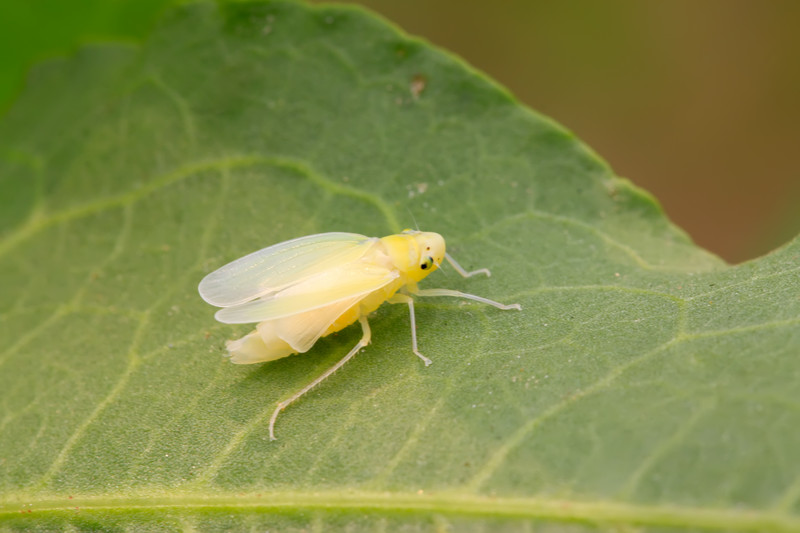Leafhoppers are wedge-shaped, slender, greenish, yellow, or brown translucent winged insects 1/10 to ½ inch long.
Nymph leafhoppers are pale green wingless insects but otherwise look like adult leafhoppers.
Leafhoppers have piercing mouthparts and suck the sap from many leafy crops such as lettuce and endive but they also attack potatoes and tomatoes.
Good Products for Pest and Disease Control at Amazon:
- Garden Safe Snail and Slug Bait
- Bonide Sulfur Fungicide
- Monterey BT Caterpillar Killer
- Neem Bliss 100-% Cold Pressed Neem Oil
- Safer Brand Insect Killing Soap
- PyGanic Botanical Insecticide

Leafhoppers are most active in spring and early summer when the weather is moderate; they are less active in dry and hot weather and in wet weather.
Leafhoppers can fly but their hind legs are long and modified for jumping. The leafhopper jumps or hops when disturbed, thus its name.
There are three destructive species of leafhoppers: aster leafhoppers feed on plants and can transmit mycoplasma which causes aster yellow disease; beet leafhoppers can transmit viral curly top disease to beets and yellows virus to tomatoes; and potato leafhoppers cause plant damage called “hopper burn” –their feeding causes leaf tips to curl and brown.
Leafhoppers undergo direct development from nymph to adult without a pupal stage. There are several generations in a year. Eggs are usually laid in plant tissue.
Aster leafhoppers are found throughout North America; beet leafhoppers are found in the western United States and Canada; and potato leafhoppers are found in the eastern United States.
Scientific name: Family Cicadellidae
Target plants
Aster leafhoppers feed on lettuce, celery, carrots, endive, and parsnips. Beet leafhoppers feed on beets. Potato leafhoppers feed potatoes, peppers, and tomatoes. Aster leafhoppers can transmit aster yellows disease; beet leafhoppers can transmit viral curly top disease to beets and yellow virus to tomatoes.
Feeding habits and damage
Adults and nymphs suck juices from green stems and the undersides of leaves. Their toxic saliva distorts and stunts plants and causes tip burn and yellowed curled leaves with white spots on the undersides. Leafhoppers also pierce and suck fruits. They leave behind drops of excrement and honeydew and can spread viral diseases.
Organic controls
Wash nymphs and adults from plants with a stiff spray of water. Attract natural enemies (predatory flies and bugs and parasitic wasps). Spray with insecticidal soap. Trap leafhoppers on sticky cardboard traps by disturbing leaves and catching them in mid-flight or hop. As a last resort, spray with neem and pyrethrin.
Organic control calendar
Here is what you can do seasonally to control leafhoppers:
- Before planting: Plant early to avoid the first wave of leafhopper activity. Use a garlic spray around the garden to repel leafhoppers.
- At planting time: Place row covers over seedbeds and transplants and seals the edges at the ground with soil; leave covers in place as long as possible to exclude leafhoppers.
- While crops develop: Place straw or aluminum foil under crops. These reflective mulches will confuse leafhoppers. Spray pests away with a strong stream of water. Sprinkle kaolin clay on plants to discourage leafhoppers from feeding and laying eggs. Spray infestations with insecticidal soap or pyrethrins if all else fails.
- After harvest: Clear the garden of all plant debris where leafhoppers can shelter. Remove host weeds such as wild mustard. Remove plants that show signs of aster yellow or beet curly top so that these diseases do not overwinter in the garden.
Natural predators
Leafhopper predators include lacewings, damsel bugs, lady beetles, minute pirate bugs, and spiders.
Related articles:
Vegetable Garden Organic Pest Control
Garden Planning Books at Amazon:
- Vegetable Garden Almanac & Planner
- Kitchen Garden Grower’s Guide Vegetable Encyclopedia
- Vegetable Garden Grower’s Guide
- Tomato Grower’s Answer Book















